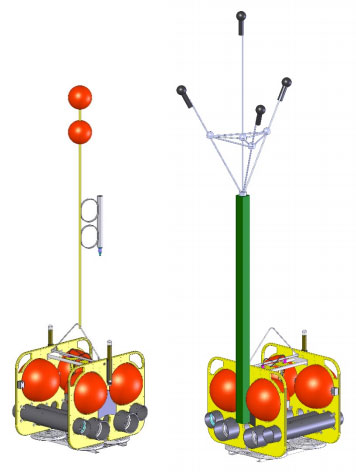Three beaked whale tracks
Three Ziphius cavirostris beaked whales (black, blue, green) tracked from their echolocation clicks using Tracking High-frequency Acoustic Recording Packages (THARPs) deployed offshore of Cape Hatteras, North Carolina at ~1100 m depth. Left panel is viewed south to north, right panel is viewed from northeast to southwest. Blue and red triangles are THARP locations ~700 m apart. Seafloor mesh surface depth colors are warm for shallow and cool for deep. Movies are sped up x60 (1s = 1 min).
Three Dimensional Tracking Beaked Whales
Passive acoustic monitoring instruments and tracking arrays
Marine mammal passive acoustic monitoring and tracking was initiated with the deployment of a large aperture array, including three High-frequency Acoustic Recording Packages (HARPs), in two different configurations: one instrument as a single hydrophone (figure on the left), and the other two using four-hydrophones arranged in a small aperture (~1 m) array (figure on the right).
Acoustic signals to track
The large aperture array allows for tracking nearly omni-directional sounds such as baleen whale calls and dolphin whistles, and in some cases, intense directional signals, for instance, sperm whale and beaked whale echolocation clicks.
Localizing sounds from array
To localize sound sources in and around a large aperture array, the arrival time of the source signal is measured at each site hydrophone and differenced with each other site to provide site-pairs of Time Difference of Arrivals (TDOAs).
Producing tracks
The measured TDOAs are compared to modeled TDOAs at each location in a Cartesian gridded model to find the source location that produces the least amount of misfit between the measured and modeled TDOAs. Successive locations in near proximity are interpreted as tracks.




